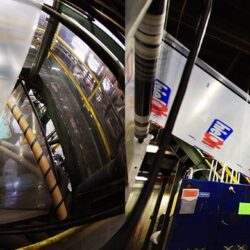In modern engineering and industrial applications, fastening components must provide reliability, corrosion resistance, and durability under varying loads. Stainless Steel Allen Bolts are one such essential fastener used globally in mechanical assemblies, construction, automotive systems, and heavy machinery. Their precise hexagonal socket head design allows torque application using Allen keys or hex wrenches, ensuring a secure and vibration-resistant fit where traditional fasteners may fail.
This blog explores specifications, advantages, grades, applications, and market trends for stainless steel Allen bolts to help engineers, procurement teams, and buyers make informed decisions.
What Are Stainless Steel Allen Bolts?
Stainless Steel Allen Bolts (also known as Hex Socket Head Bolts or Allen Cap Screws) feature a hexagonal recess in the head that allows tightening using a hex key instead of standard wrenches. They are manufactured with different head styles such as:
-
Socket Head Cap Screw
-
Button Head Screw
-
Flat Head Countersunk Screw
-
Low-Head Socket Screw
The hex socket design ensures better torque transmission and reduces the chances of slipping or damaging the bolt head—making them ideal for precision assemblies with limited surface space.
Technical Specifications and Standards
Allen bolts are manufactured according to global standards ensuring consistent quality and performance:
| Standard | Region | Description |
|---|---|---|
| ASTM A193 / A194 | USA | High-temperature & pressure applications |
| DIN 912 / DIN 7991 | Europe | Socket head cap screws / countersunk screws |
| ISO 4762 / ISO 7380 | International | Metric hex socket bolts |
Common Size Range:
-
M3 to M48 (metric)
-
1/4” to 2” (inch series)
-
Lengths up to 300 mm or custom
Thread Types:
-
Full Thread
-
Partial Thread
-
Coarse & Fine Pitch
Why Stainless Steel for Allen Bolts?
Stainless steel fasteners are preferred due to their:
✅ High corrosion resistance
✅ Excellent mechanical strength
✅ Fire and temperature resistance
✅ Clean aesthetic appeal
✅ Long service life in harsh environments
These advantages significantly reduce the maintenance cost and enhance equipment safety.
Best Stainless Steel Grades for Allen Bolts
Different stainless steel grades support different operational conditions:
| Grade | Major Element Addition | Characteristics | Common Uses |
|---|---|---|---|
| SS 304 / 304L | Chromium & Nickel | General corrosion resistance | Construction, machinery, furniture |
| SS 316 / 316L | Molybdenum | Superior seawater & chemical resistance | Marine, pharmaceutical, food plants |
| SS 310 / 310S | High Cr & Ni | Excellent high-temperature strength | Furnaces, exhaust systems |
| SS 410 | Martensitic SS | High hardness & wear resistance | Automotive, industrial equipment |
📌 SS 304 accounts for approx. 50–60% of global stainless fastener production due to cost-to-performance benefits.
Manufacturing Process of Allen Bolts
A precisely controlled manufacturing process ensures dimensional accuracy and strength:
-
Material Selection – Choosing the right SS grade & diameter
-
Cold/Hot Heading – Forming head shape
-
Thread Rolling – Precise and strong thread creation
-
Heat Treatment (if applicable) – To achieve required hardness
-
Surface Finishing
-
Polished
-
Passivated
-
Coated if needed
-
-
Quality Testing – Tensile, torque, hardness, corrosion tests
Factories use advanced CNC machining and forging systems to ensure tight tolerances and high load-bearing performance.
Advantages of Stainless Steel Allen Bolts
| Feature | Benefit |
|---|---|
| Hexagonal Socket Design | Efficient torque transmission and compact head |
| High Tensile Strength | Withstands vibrations and heavy loads |
| Corrosion Resistant | Ideal for outdoor and chemical environments |
| Reusable & Long-Lasting | Reduces replacement frequency |
| Clean Industrial Look | Perfect for visible assemblies |
Their ability to secure joints in restricted spaces is a key reason engineers prefer them over traditional bolts.
Applications of Stainless Steel Allen Bolts
Stainless steel Allen bolts are used in high-precision and load-critical zones. Major industries include:
1. Automotive & Transportation
-
Engine components
-
Brake systems
-
Suspension assemblies
2. Construction & Architecture
-
Structural steel frameworks
-
Glass railing systems
-
Elevators and escalators
3. Aerospace & Defense
-
Aircraft seats and fuselage parts
-
Missile assembly fastening
-
Vibrational equipment
4. Marine & Offshore
-
Shipbuilding
-
Subsea equipment
-
Saltwater-exposed structures
5. Energy & Power Generation
-
Wind turbines
-
Heat exchangers
-
Solar panel mounting frames
6. Industrial Machinery
-
Robotics
-
CNC machines
-
Conveyor systems
Global Market Insight:
The stainless steel fastener market is projected to reach USD 4.9 Billion by 2028, driven by construction, renewable energy, and automotive expansion worldwide.
Allen Bolt Head Styles & Where They Fit Best
| Head Type | Suitable For | Benefits |
|---|---|---|
| Socket Head Cap | High-strength mechanical assemblies | Compact with high torque |
| Button Head | Aesthetic exposed joints | Wider bearing surface |
| Countersunk Flat Head | Flush finish required | Used in aerospace & furniture |
| Low Head | Space-restricted components | Lightweight assemblies |
How to Select the Right Stainless Steel Allen Bolts
When purchasing, consider:
🔹 Grade (304, 316, 310 etc.)
🔹 Corrosion environment
🔹 Mechanical load conditions
🔹 Temperature range
🔹 Required precision & standards
🔹 Thread type & head style
🔹 Certification availability (EN 10204, PMI testing)
Correct selection ensures safety, durability, and project efficiency.
Comparison: Stainless Steel Allen Bolts vs. Mild Steel Bolts
| Feature | SS Allen Bolts | Mild Steel Bolts |
|---|---|---|
| Corrosion Resistance | Excellent | Poor |
| Service Life | Long-lasting | Short |
| Cost | Higher | Lower |
| Appearance | Smooth & polished | Basic |
| Ideal Use | Critical structures | Low-risk indoor usage |
Conclusion: Mild steel is cheaper, but stainless steel delivers long-term performance and safety—making it the better investment.
Future Market Trends
Some emerging technologies for Allen bolts include:
-
Anti-galling coatings for stainless threading
-
Smart fasteners with torque monitoring sensors
-
Lightweight advanced alloys for aerospace and EVs
-
Automated robotic fastening systems
Industries are increasingly prioritizing performance, sustainability, and safety, boosting demand for stainless fasteners.
Conclusion
Stainless Steel Allen Bolts are crucial components for precision, durability, and safety in engineering applications. Their combination of high-strength performance, corrosion resistance, and versatility make them indispensable in demanding environments—from marine structures to aerospace assemblies.
Whether you are a manufacturer, engineer, or procurement manager, choosing the right grade, size, and certified product ensures long-term reliability in your operations. As the global industrial sector continues to grow, the relevance and necessity of stainless steel Allen bolts will only increase.




